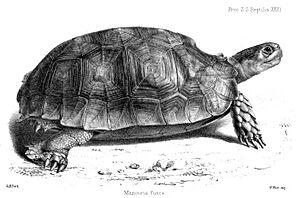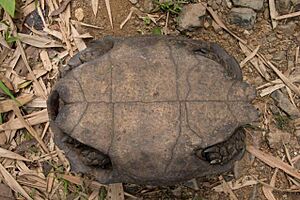Asian forest tortoise facts for kids
Quick facts for kids Asian forest tortoise |
|
|---|---|
 |
|
| Manouria emys from Kaeng Krachan National Park in Thailand | |
| Conservation status | |
| Scientific classification | |
| Genus: |
Manouria
|
| Species: |
emys
|
| Synonyms | |
|
List
Testudo emys emys
Testudo emys phayrei
|
|
The Asian forest tortoise (Manouria emys) is a really big tortoise found in Southeast Asia. People also call it the Mountain tortoise or Burmese Brown Mountain tortoise. Scientists think it's one of the oldest types of tortoises still alive today, based on how its body is built and its DNA.
Contents
Meet the Asian Forest Tortoise Family
There are two main types, or subspecies, of the Asian forest tortoise.
- One type, called M. e. emys, lives in southern Thailand, Malaysia, Sumatra, and Borneo.
- The other type, M. e. phayrei, is found from northwestern Thailand all the way to northeastern India. This one was named after a British officer named Sir Arthur Purves Phayre.
Scientists study the Manouria group of tortoises. They believe these tortoises are very old and important in the tortoise family tree.
What Does the Asian Forest Tortoise Look Like?
The Asian forest tortoise is the largest tortoise in mainland Asia. The biggest ones, especially the northern type Manouria emys phayrei, can weigh about 25 kg (55 lb) in the wild. Some in zoos can weigh even more!
Shell and Body Features
The tortoise's top shell, called the carapace, is quite flat. Its front and back edges are a bit turned up and can be jagged. It has two special shields near its tail. The shields on its back often have rings, like tree rings.
The bottom shell, called the plastron, is large. The front part is a bit pointy and usually has a notch. The back part is deeply notched.
Its head is a medium size. It has two large shields on its forehead and one big shield in the middle. Its beak isn't hooked, and its jaws have small teeth-like bumps.
Legs and Skin
The front legs have very big, bony, pointed bumps. These bumps form rows. The back legs also have large bony bumps on the bottom of their feet. There are also bigger, cone-shaped bumps on their heels and on the back of their thighs.
Coloration
Adult tortoises are usually dark brown or black. Young tortoises have a yellowish-brown shell with dark-brown markings.
Where Do They Live?
The Asian forest tortoise lives in several countries in Southeast Asia. You can find them in Bangladesh, Cambodia, India, Indonesia, Malaysia, Myanmar, Thailand, and Vietnam.
What Do They Eat?
In the wild, these tortoises eat many different plants. They enjoy whole fungi, young shoots of plants like koster's curse and elephant ears. They also eat leaves, stems, and flowers of wild ginger. They especially love plants from the Alocasia family. Sometimes, they even stand almost straight up to reach the leaves!
When kept by humans, they eat a wide variety of foods. They mostly eat plants, but sometimes they will also eat frogs, snails, or even dead animals if they find them.
How Do They Reproduce?
The Asian forest tortoise is special because it's the only tortoise that lays its eggs above the ground. The female builds a nest using leaf litter. She uses both her front and back legs to gather leaves and other materials. She then lays up to 50 eggs deep inside this nest.
After laying the eggs, she stays on or near the nest to protect it. She will even try to scare away animals or people who get too close!
Egg Incubation and Sex Determination
Scientists have studied how the temperature affects the eggs. They found that a temperature around 29.29°C (about 84.7°F) is a key point.
- If the eggs are incubated at temperatures higher than this, most of the baby tortoises will be female.
- If the temperature is lower, most will be male.
The temperature also affects how long it takes for the eggs to hatch. Higher temperatures mean the eggs hatch faster. Lower temperatures mean they take longer. Eggs usually hatch between 60 and 90 days.





